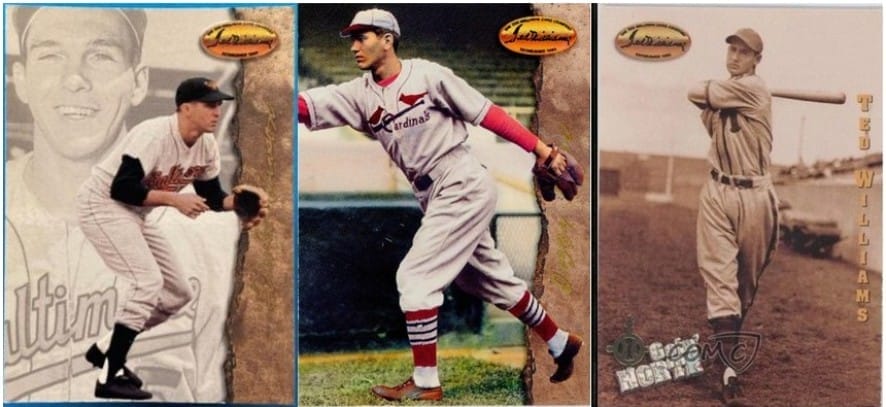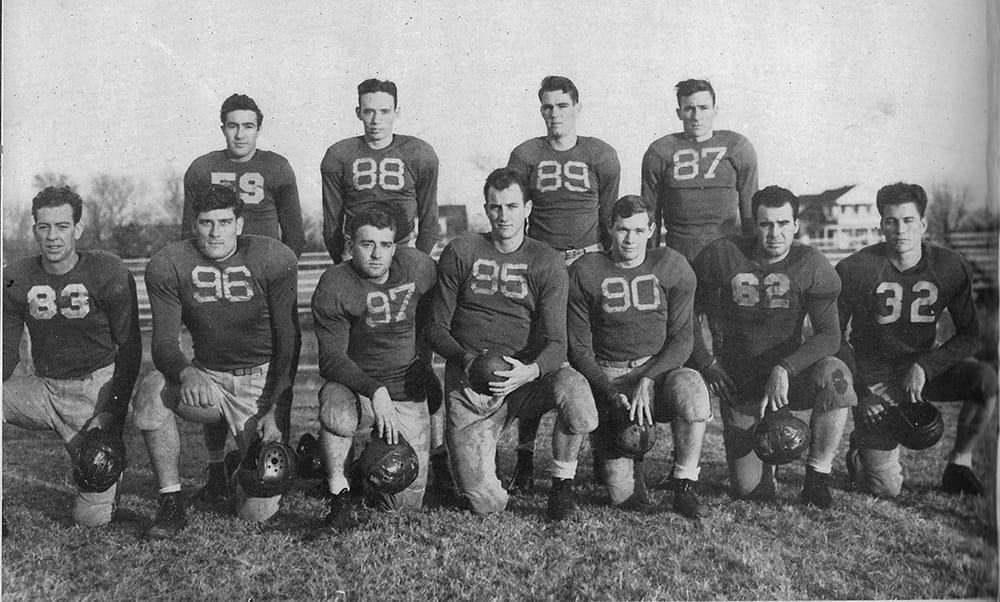

Uh oh...
It appears that you're using a severely outdated version of Safari on Windows. Many features won't work correctly, and functionality can't be guaranteed. Please try viewing this website in Edge, Mozilla, Chrome, or another modern browser. Sorry for any inconvenience this may have caused!
Read More about this safari issue.

In 1994, Hall of Famer Ted Williams was contracted to create his personal edition of baseball cards. Williams was asked to build a collection honoring some of baseball’s most accomplished players, both past and present. Not known for modesty or reticence, Williams chose himself for card number one.
Williams selected many of baseball’s all-time greats, including Arkansans Brooks Robinson and Dizzy Dean. Not surprisingly, the Hall of Famer known as the “Splendid Splinter,” also included a second card of himself as card number 143.

Perhaps the most unexpected selection for Williams’ set was a forgotten outfielder from the late 1940s with a .224 lifetime batting average. Card number 152 was an obscure power hitter named James Patrick Seerey.
Seerey’s only statistical notoriety came from the unfortunate distinction that he led American League hitters in strikeouts in four of his seven big league seasons. His manager didn’t particularly like him as an individual or a player, sometimes writing Seerey’s name in the batting order only because he had no other viable choice.
When asked about Seerey’s inclusion, Williams responded, “He did something that I never did.”
Seerey came out of Little Rock, Arkansas, with a charming southern accent, a soft middle, and a likability factor that was off the charts. He played in a time when a good batting average was the ultimate player statistic, and home runs at the cost of a league-leading strikeout total were not acceptable. Despite his shortcomings, fans loved him. Seerey swung from his heels and occasionally hit home runs, often with flair and drama.
Pat Seerey was born in Oklahoma in 1923, but his family moved to Arkansas when he was a child. As a teenager, he was a highly regarded football player at Little Rock Catholic High School. Seerey’s best sport, however, was baseball, where he caught the attention of pro scouts while playing for an outstanding American Legion team known as the Doughboys.
In the spring of 1941, before his high school graduation, Seerey signed with the Cleveland Indians. The Indians rushed him off to spring training just after his 18th birthday. When his class graduated from Catholic High, Seerey was playing for the Appleton Papermakers in the Wisconsin State League. The young fellow from Arkansas became an instant hero, hitting a game-winning home run in his first game as a Papermaker.
The 3,000 fans who were watching the game went wild, and members of the Papermakers squad galloped to the third base line to take picks on various parts of Pat’s anatomy as he rambled the last 90 feet to the plate…And after they got through, there were the kids, and all the folks Pat had to pass on the way to the dressing room. His reward was a new pair of shoes.
Seerey hit .330 for the Papermakers in his first professional season. His 31 home runs and 117 RBIs far exceeded any of his teammates, as did his 111 strikeouts, a combination of statistics that would be commonplace today, but unacceptable in Seerey’s day.
After an excellent year in Appleton, 19-year-old Seerey moved up to Cedar Rapids, Iowa, in 1942. His 33 home runs and 94 RBIs led the Three-I League in both categories. A year later, at age 20, Seerey was promoted to the Cleveland Indians, and despite his manager’s dislike for his “free swinging” style, he was a regular big-league outfielder by 1944.

Seerey’s arrival in Cleveland immediately created an uncomfortable relationship between the young Arkansan and his player-manager, Lou Boudreau. The age-old baseball approach of “get ‘em on, get ‘em over, get ‘em in” was the foundation of Boudreau’s managerial strategy. The manager was convinced that games were won by putting the ball in play and lost by striking out with runners on base. Seerey believed, “swing hard and occasionally good things will happen.”
Seerey did have two things in his favor. Perhaps, most importantly, he was available. He had been declared 4-F by his draft board back in Arkansas. During wartime, with hundreds of professional baseball players serving in the military, being draft-exempt was an attractive item on a player’s resumé. Another influential plus for the young slugger was that Cleveland fans loved the home run idea.
Extraordinary moments of greatness expected of stars like Ted Williams occurred randomly in the ordinary baseball life of Pat Seerey. A heavy-set, wild swinging, Irish kid from Arkansas, Seerey grinned a lot, and Cleveland loved him. He looked like the guy from their bar, and he had an “everyman” persona that caught on immediately with the Indian’s fans. Despite his manager’s frustrations, Pat Seerey was a fan favorite. The Cleveland press labeled their local hero, “The People’s Choice.”
One example of Seerey’s historic performances occurred on Friday, July 13, 1945, in Yankee Stadium. The governor of New York, Thomas Dewey, was in attendance with his family, and the Yanks should have gotten the message right away that this was not their lucky day.
Before New York fans had settled into their seats, Pat Seerey hammered an uncharacteristic triple to the cavernous no-man’s land in Yankee Stadium. He was just beginning. Seerey followed the triple with three home runs and eight runs batted in. While fans were sure they had witnessed Pat Seerey’s “career day, there would be another, more amazing performance to come.
The 1946 season would see Seerey hit a career high, 26 home runs, but his .225 batting average and league-leading 101 strikeouts were unacceptable to Lou Boudreau, and now the manager had choices. Major Leaguers who had served in WWII were coming home, and Seerey’s days in Cleveland were obviously coming to an end.

Despite his popularity in Cleveland, the Indians traded the 25-year-old fan favorite to the Chicago White Sox in early June of 1948. “Fat Pat Seerey, who could hit a ball a mile but couldn’t do it often, climbed down the ladder today from first-place Cleveland to last-place Chicago.” -AP
Although he was only 25 years old, Seerey’s career was in a steep decline. He played fewer than 100 major league games after going to Chicago. Ironically, one of those games was among the most outstanding individual performances in big league history.
On Sunday, July 18, 1948, the second-place Philadelphia A’s hosted the last-place White Sox for a doubleheader at historic Shibe Park. The A’s jumped out to a 5–1 lead after three innings of what was looking like a routine win for the home team.
After striking out in his first at-bat, Pat Seerey led off the fourth inning with a solo home run to make the score 5–2. The A’s added another run in their half of the fourth before Seerey hit his second home run in the fifth inning—this time a two-run shot that narrowed the A’s lead to six to four.
In the sixth inning of the slugfest, Seerey ‘s third homer of the day contributed three runs to Chicago’s five-run inning. The White Sox now led 9–7, and Pat Seerey was in the midst of a historic adventure that added his name to a short list of major league hitters.
The game entered the ninth inning tied at 11, and, with the home crowd on its feet, A’s pitcher Joe Coleman walked Seerey to load the bases. A harmless pop-up ended the White Sox’s ninth inning, sending the game into extra innings.

Pat Seerey’s Big Day, July 18, 1948
Of course, Seerey hit the go-ahead home run in the top of the 11th inning, becoming the fifth player in big-league history to hit four home runs in a single game. The Sporting News calls hitting four home runs in one game “The greatest single-game accomplishment in baseball.”
The 1948 season would be Seerey’s last full season in the majors. He played three more pro seasons, including an excellent year with Colorado Springs in 1950, where he batted .300 and hit 44 home runs. After retiring in 1951, Pat Seerey became a school custodian in St. Louis. He died in Jennings, Missouri, in 1986.
Ted Williams’ 1994 Pat Seerey card can be purchased on eBay.
Join the Conversation
Leave a Comment
One response to “The Lost Story of Arkansas’s Pat Seerey”
 Leave a Reply
Leave a Reply
We do the work.
You check your email.
Sign up for our weekly e-news.
Get stories sent straight to your inbox!











 Leave a Reply
Leave a Reply
Nice story.